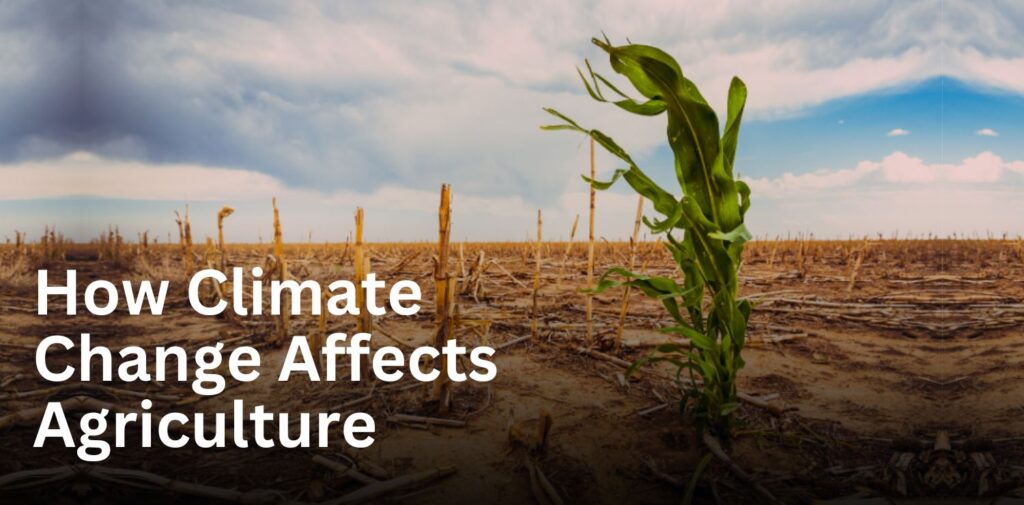Climate change is not just a distant threat; it’s a reality that affects our daily lives, especially in countries like India. With its vast agricultural landscape, India faces unique challenges due to climate change. As one of the largest producers of crops in the world, India’s farmers play a crucial role in feeding its population of over 1.4 billion. However, the changing climate is putting immense pressure on this vital sector. In this article, we will explore how climate change impacts agriculture in India and what it means for the future.
Understanding Climate Change
Climate change refers to long-term shifts in temperatures and weather patterns. While these changes can occur naturally, human activities—especially the burning of fossil fuels and deforestation—have significantly accelerated the process. Rising temperatures, unpredictable rainfall, and extreme weather events such as floods and droughts are becoming more common.

Agriculture in India: The Backbone of the Economy
Agriculture is a cornerstone of the Indian economy, contributing about 18% to the country’s Gross Domestic Product (GDP) and employing nearly half of the workforce. The diverse climate across regions allows for a variety of crops, from rice and wheat to spices and pulses. However, this diversity also means that agriculture is particularly vulnerable to climate changes that can disrupt traditional farming practices.

How Climate Change Affects Agriculture
- Changes in Rainfall Patterns: One of the most significant impacts of climate change is altered rainfall patterns. In India, the monsoon season is crucial for agriculture, providing the necessary water for crops. However, climate change has led to irregular monsoons, with some regions experiencing heavy rains while others face droughts. This inconsistency makes it difficult for farmers to plan their planting and harvesting schedules, leading to crop failures and reduced yields.
- Rising Temperatures: Increased temperatures can directly affect crop growth and yields. Different crops have specific temperature ranges within which they thrive. For instance, wheat and rice, staple foods in India, are sensitive to temperature changes. As temperatures rise, these crops may struggle to grow, leading to lower productivity. In addition, higher temperatures can lead to increased evaporation rates, which further depletes soil moisture and stresses crops.
- Extreme Weather Events: India is witnessing more frequent and severe weather events, including floods, cyclones, and heatwaves. These extreme events can devastate crops, destroy farmland, and displace farmers from their homes. For example, the floods in various parts of India have caused significant damage to paddy fields, leading to food shortages and economic losses.
- Soil Degradation: Climate change can lead to soil degradation through erosion, loss of nutrients, and salinization. Changing rainfall patterns can wash away topsoil, making it harder for crops to grow. Moreover, increased temperatures can accelerate the decomposition of organic matter in the soil, further reducing its fertility. Healthy soil is vital for productive agriculture, and its degradation can have long-lasting impacts on food security.
- Pest and Disease Proliferation: Warmer temperatures and changing rainfall patterns create favorable conditions for pests and diseases to thrive. This can lead to increased crop losses and higher costs for farmers who need to invest in pesticides and other control measures. For example, the increase in certain pests, like the cotton bollworm, has already affected cotton production in India, a major cash crop.
The Socio-Economic Impact
The effects of climate change on agriculture extend beyond the fields. Many farmers in India are already struggling to cope with these changes, and the socio-economic impacts can be severe.
- Food Security: With a population that continues to grow, food security is a pressing issue. Reduced agricultural productivity due to climate change can lead to higher food prices and increased hunger, particularly among vulnerable populations. India already faces challenges in ensuring that everyone has access to adequate nutrition, and climate change threatens to exacerbate this situation.
- Farmer Livelihoods: Many farmers in India are smallholders who rely on agriculture for their livelihoods. Crop failures and increased costs due to climate-related challenges can push these farmers deeper into poverty. This economic strain can lead to mental health issues, social unrest, and, in severe cases, farmer suicides, a tragic reality in many rural areas.
- Migration: As agricultural conditions worsen, many farmers may be forced to migrate to urban areas in search of better opportunities. This migration can lead to overcrowding in cities and increased pressure on urban resources, creating a cycle of challenges for both rural and urban communities.

Strategies for Adaptation
While the challenges posed by climate change are daunting, there are strategies that can help mitigate its impact on agriculture in India.
- Sustainable Farming Practices: Encouraging sustainable agricultural practices can help improve resilience to climate change. Techniques such as crop rotation, intercropping, and organic farming can enhance soil health and reduce dependency on chemical fertilizers. Farmers can also adopt climate-resilient crops that require less water or can tolerate higher temperatures.
- Improved Water Management: Efficient water management is crucial in adapting to changing rainfall patterns. Techniques like rainwater harvesting, drip irrigation, and the use of drought-resistant crops can help farmers make the most of available water resources. Government initiatives to improve irrigation infrastructure can also play a significant role in supporting farmers.
- Climate Information Services: Access to timely and accurate weather forecasts can help farmers make informed decisions about planting and harvesting. Implementing climate information services can empower farmers with the knowledge they need to adapt to changing conditions. Mobile apps and other digital tools can provide valuable data and advice on weather patterns and best practices.
- Government Support and Policy Changes: The government can play a crucial role in supporting farmers facing the challenges of climate change. Policies that promote sustainable agriculture, provide financial assistance during crises, and invest in research for climate-resilient crops can make a significant difference.
- Community Engagement and Education: Building awareness and fostering community engagement are essential in adapting to climate change. Farmers can benefit from sharing knowledge and experiences with one another, creating a support network that strengthens resilience. Educational programs that focus on sustainable practices and climate adaptation strategies can empower farmers to take action.
Conclusion: Impact of Climate Change
The impact of climate change on India’s agriculture is profound and multifaceted. As we face the reality of changing weather patterns, rising temperatures, and extreme weather events, it is essential to recognize the challenges ahead. However, by adopting sustainable practices, improving water management, and implementing supportive policies, we can work towards a more resilient agricultural sector. Protecting the livelihoods of farmers and ensuring food security for future generations must be a priority. Together, we can combat the impacts of climate change and safeguard the future of agriculture in India.




